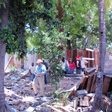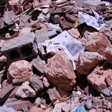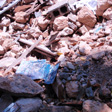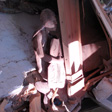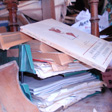Centre d’Art
The Centre d’Art has for sixty years been an important creative center in Haiti, training hundreds of artists, providing archives and resources for painters, sculptors and other creative people such as artists, playwrights and designers. It is a quasi-public, non-profit cooperative with artists as members and an elected board.
Its collection of thousands of paintings, sculptures and artisanal objects, thousands of archival records and other materials were severely damaged when the building housing the Center suffered a total collapse in the earthquake. Staff and members who could get to the site went to work immediately for one month, pulling items out of the rubble by hand, without benefit of appropriate tools or heavy equipment. They succeeded in borrowing two tractor-trailer containers which they used to store the paintings, papers, sculptures and other materials they rescued. Lacking any resources and requisite conservation skills and equipment, those trailers sat in the sun without proper ventilation for almost eight months. As a result, the conditions encouraged the development of mold and infestation. The collection was terribly endangered.
The Haiti Cultural Recovery Center worked with Centre d’Art staff, board members and supporters to develop a project to save the collection. First, U.N. Japanese engineering troops and their heavy equipment were engaged to help the Center’s [Smithsonian] conservators, ICCROM trainers and Centre d’Art staff remove rubble and rescue additional art works and archives. Hundreds of artworks and thousands of documents were pulled out of the rubble.
Secondly, the material rescued from the rubble along with the two containers were transported to the Haiti Cultural Recovery Center. Chief Conservator Stephanie Hornbeck developed a processing methodology, which was tested by Haitian trainees during case studies in the ICCROM course and then undertaken by a team of eight Haitian colleagues. The process involved: to remove items, quarantine some where necessary, catalog and photograph all items, stabilize them by vacuuming and dry cleaning methods and store them in stable conditions. The Center provided equipment and materials, temporary storage and shelving and employed a complement of Centre d’Art personnel so they could learn to treat, manage, and care for the damaged collections.
To guide the assistants with learning stabilization treatments, Hornbeck and HCRC training coordinator Fritz Berg Jeannot organized two short training sessions. In December, Paul Jett (FSG, SI), Jane Norman (formerly FSG, SI) and Hornbeck taught a basic workshop on the conservation of iron objects. In February, Rosemary Fallon (NPG, SI) and Emily Jacobson (FSG, SI) taught a basic workshop on paper conservation.
The Centre d'Art team was headed by Marie Lucie Vendryes and included Annette Augustin, Jean Menard Derenoncourt, Marise Desrosiers, Marc Gerard Estimé, Erntz Jeudy, Eddnyio Jeune, and Franck Louissaint. Hornbeck met regularly with Vendryes to provided guidance as needed, as the team processed paintings and works on paper over a six-month period.
A second six-week phase involved processing the Centre d'Art's significant collection of fer découpé (cut ironwork) sculpture, which numbers nearly 350 objects. The collection includes both sheet metal and forged objects, including a number created by early master sculptor Georges Liautaud and first generation artists Murat Brierre, the Louis-Juste brothers, Gabriel Bien-Aimé,and Serge Jolimeau. These works suffered severe deformation, corrosion, and accretions of surface dirt from the earthquake and subsequent burial in the rubble. Processing phases include: inventory, photography, condition assessment, and surface-cleaning by vacuum and dry cleaning methods. This team was headed by Hornbeck and included object conservator Anais Gailhbaud and assistants Marc Gerard Estimé, Erntz Jeudy, Eddnyio Jeune, and God-Freed Enoi.
Eight months after beginning their work, over 4,000 paintings, some 1,000 350 sculptures, 500 works on paper and numerous administrative documents and other items of the Centre d'Art Collection have undergone stabilization treatment. A committee of art historians, including Vendrys, Mireille P. Jérome and Axelle Liautaud has prioritized the permanent collection by patrimonial value. A number of the most important works that are also badly damaged are now undergoing conservation treatment by AIC and Smithsonian conservators in the Center's conservation studios. In addition, Almost 200 works of art that had been loaned to the Centre d'Art before the earthquake have now been returned to various Haitian artists.










